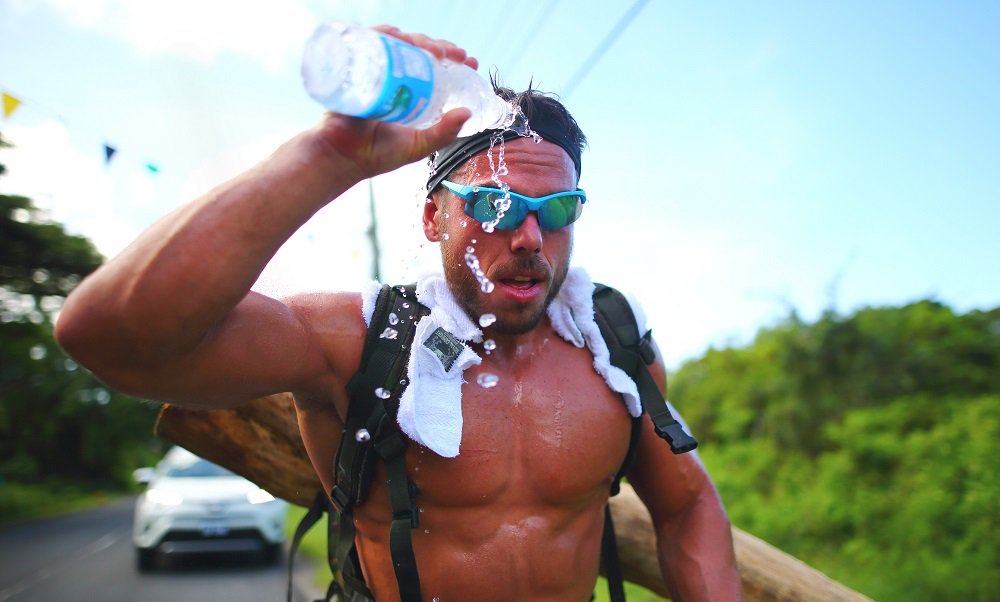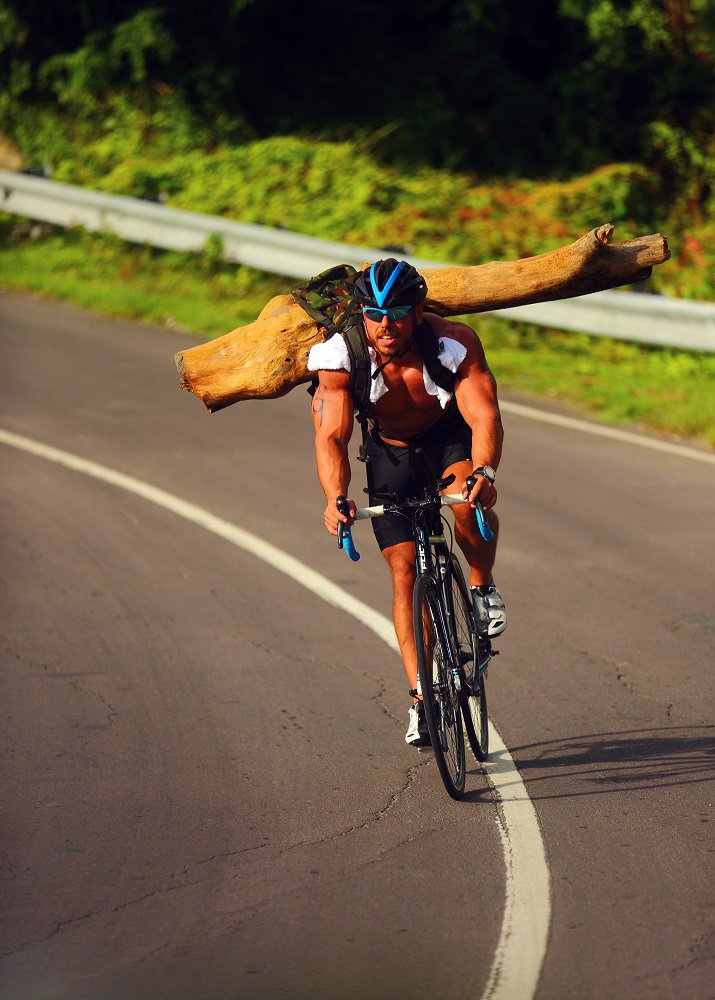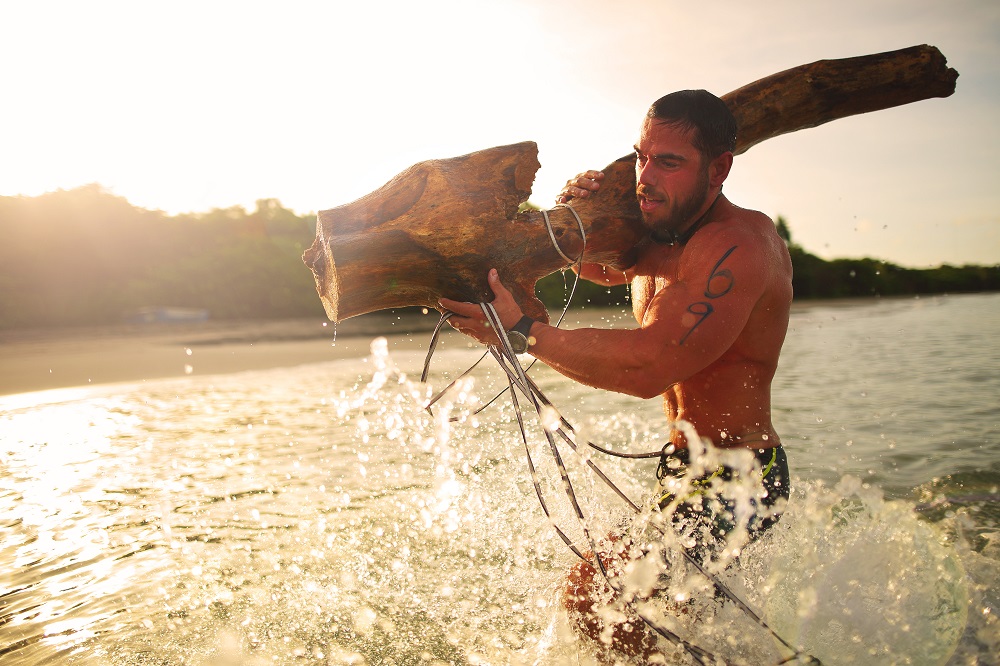Training for the world’s first ‘tree-athlon’
By Will Stroude

In 2016 athlete adventurer Ross Edgley completed an Olympic-distance triathlon — 1.5km swim, 40km bike ride and 10km run — carrying a 100-lbs tree. Why? To raise awareness for the Caribbean Island of Nevis and its pioneering eco-friendly technology. Dubbed, “The World’s First Tree-athlon” here Ross details how the training techniques he learnt are far from conventional, but could prove to be invaluable to your 2017 training.
Before 2016 I had never attempted a triathlon. Which is why to most people it seemed odd that when the clock struck 7:00am on the 12th of November I decided I would attempt to swim 1.5km, cycle 40km and run 10km with a 100lbs tree on my back. The reason for my newly-invented sport? To bring global attention to the Caribbean Island of Nevis and its pioneering work in green energy.
Now I won’t lie — despite having a great title — it was not pretty, pleasant or fast. But after many tree-induced bruises I finished sore and successful. Looking back, from the comfort of my sofa sipping a whey protein shake, here are Lessons from The World’s First Tree-athlon. You won’t find them in any gym or diet book, but each could prove invaluable to your 2017 training.
1) Tree-Athlon Training is Sporadic
It took exactly 12 weeks to condition my body to complete the tree-athlon. Swimming, cycling and running for up to 30 hours per week — sometimes with the tree and sometimes not — my training routine was best described as sporadic at first. This is because during my first 2 weeks of training my lower back wondered, “What are you thinking?” And my legs and lungs agreed.
But I was moving and that was the important thing. This also raised a great point, since researchers from the Department of Sport, Health and Exercise Science at the University of Hull, stated there is no universally agreed consensus on the best way to train for endurance. This is especially true when creating a new sport like the tree-athlon where no training blueprint exists.
Tree-athlon Lesson Number 1: Therefore the first lesson from my Tree-Athlon training is for those people new to endurance-based sports. Basically don’t worry too much about training times, splits and distance when starting out, simply get moving.
2) Tree-Athlon Training Burns Fat & Builds Muscle
As well as swimming, cycling and running 30 hours a week, I was also continuing with a basic strength training routine that consisted of a 45-minute-per-day powerlifting routine that I adapted to condition my legs, back and core to carry 100-lbs as comfortably as possible. But I found amazing was — and this is contrary to gym folklore — my muscles didn’t shrivel up. Instead my full body medical before training (9th July 2016) and after (4th November 2016) revealed I had managed to.
- Lose 5.6kg overall bodyweight
- Lose 8.8kg of fat
- Increase 3.05kg muscle mass
- Halve my visceral fat
| Pre-Training Test | 9th July 2016 | Post-Training Test | 4th November 2016 | |
| Weight | 91.7kg | 86.1kg |
| Fat Mass | 17.5kg | 8.7kg |
| Muscle Mass | 70.55kg | 73.6kg |
| Visceral Fat | 6 | 3 |
So what exactly happened here? And are strength athletes justified in their complete fear (and disdain) of all things cardio?
Presenting both sides of the argument, let me explain where the idea that “cardio eats your muscle” comes from by detailing the work of Robert Hickson and his theory on “concurrent training”. This is a training method where more than one component of fitness is trained and where an athlete is basically trying to become faster, stronger and more muscularly endured in the same session. According to Hickson’s research published in 1980 in the European Journal of Applied Physiology and Occupational Physiology ― and supported by studies in the field of molecular biology ― this approach will produce less than optimal results all because it dilutes your effectiveness to improve a specific component of fitness.
Put simply, your body doesn’t know whether to become faster, stronger, more mobile or more endured, since the “potency” of your training is lost. Supported by research from the Division of Molecular Physiology at the University of Dundee it’s believed combining too many forms of training “blocks each other’s signaling” to adapt.
But with a tree attached to my trunks I found this wasn’t quite true.
A possible reason for this is because science often has a habit of researching topics in isolation. Researchers will compartmentalize things that aren’t really compartmentalized in nature. Instead I think we should learn to view the human body in its powerful entirety?

Take a study from the Department of Health Sciences at Mid Sweden University in Östersund for example. What scientists found was that when strength training was fused with cardio it could actually “elicit greater muscle hypertrophy than strength exercise alone.” What this means is, contrary to Hickson’s research, hitting the weight’s room (strength) and treadmill (cardio) could increase the size and strength of your muscles.
What was the reason for this? Well, it’s well reported that cardiovascular conditioning can dramatically improve your capillary density. Capillaries are the small blood vessels that network through your muscles. So it stands to reason that by increasing their density you also increase your ability to supply the muscles with blood and oxygen during training.
For many strength athletes this is the most overlooked aspect of their training. But is an aspect that’s been embraced by some of the strongest men in history. Take famed strongman Geoff Capes as an example, winning the World’s Strongest Man twice (1983 and 1985) very few people know that standing 6ft 5in and weighing 23 stone he had an impressive collection of marathon medals in his trophy cabinet and was able to run 23.7 seconds for the 200m.
Now there’s no denying Geoff was a genetic specimen, but research also supports this idea of caring for your capillaries. Take a study published in the Journal of Applied Physiology as an example where scientists set out to monitor the adaptive changes in the muscles that occur during a 24-week training program that was heavily orientated around cardiovascular training. Muscle biopsies revealed all subjects had, “An increased capillary supply of all muscle fiber types.” Which lead me to my first lesson:
Tree-athlon Lesson Number 2: Workouts that include both strength and stamina can produce faster recovery between bouts of intensive training (by improving the density of your capillaries) which in turn can mean more weight lifted for more repetitions and more sets therefore more muscle built.

1) Tree-Athlon Training Conditions Your Ab
After months of “tree training” my core was the most conditioned it had ever been. Not by performing endless sit-ups, but from balancing a log on my bike for miles and miles, uphill and a steep gradient. This is based on research from the Département de Mécanique Appliquée at the Université de Franche-Comté that studied muscle activation during 2 different pedaling positions on a bike.
What researchers found was pedaling in an uphill position lead to a “significant” effect on the muscle activity in the entire body and not just the lower body and legs. Notably they found the “lateral sways” of the bike lead to an increase in activation in the triceps, glutes, biceps and the rectus abdominis muscles (the muscles of the stomach).
This coupled with the demand for oxygen meant my core was working overtime, both to breathe and supply my (now suffering) legs with oxygen, but also balance the tree on my back and stabilize my body.
An idea supported by research conducted at the University of Jyväskylä, in Finland who analyzed how upper body stabilization exercises engaged the abdominal muscles more than a conventional “crunch”. What they found was these “holding” exercises ― like running or cycling with a tree ― elicited a “Sufficient level of contraction of the trunk muscles for the development of their endurance and strength characteristics.”
Tree-athlon Lesson Number 3: The simple act of stabilizing the body can be a valuable tool in core conditioning. Yes, you can run and cycle with a tree, but equally planks and holds offer an equally valuable training protocol.
So there you have it, 3 ways to Train for the World’s First Tree-athlon. You don’t necessarily have to need to find yourself a tree and swim, cycle and run with it, but just take inspiration from the lessons learnt. Next I will detail 3 ways to Eat for the World’s First Tree-athlon that comes with recipes, vegan protein and high-calorie protein desserts.
Ross Edgley is an athlete adventurer and fitness and food writer. Follow him on Facebook, Twitter and Instagram
More stories:
Sydney is having its biggest party of the year – WIN flights for two!
Drag Race’s Katya is hosting National Student Pride’s talent competition
